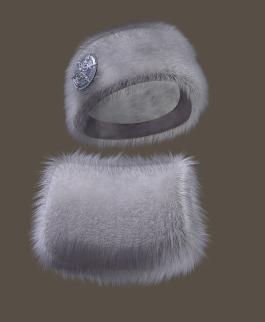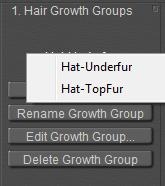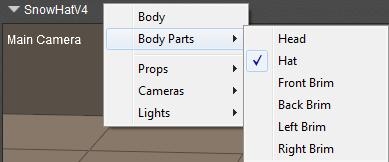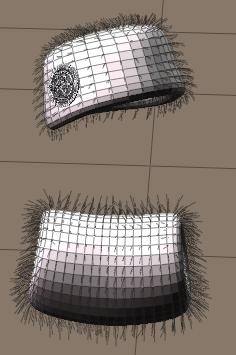Snow Bride is a commercially available set of clothes for the well-known Vicky4 character. The clothes are fur, and look like this.
Let’s analyze the parameters, and learn from them.
Structure
The hat as well as the muff have an Underfur as well as a Top-fur hair growth group, that’s four in total. and The other object parts have no hair groups. This is found out by selecting each part of each object looking in panel 1 which tells me about the available hair groups.Clicking [Edit Growth Group] tells me that the inner bands, and the medallion on the hat are neatly excluded from the groups.
Guide hairs
For each hair growth group selected in panel 1, I looked at panels 2 and 3 and noted the numbers. The three Pull parameters were 0,0 in all cases, and indeed all hairs grow right up from the surface.
| &ndsp; | Hat-topfur | Hat-underfur | Muff-topfur | Muff-underfur |
| Polygon size | 2,5×1,6=4cm2 | 1,4×1,4=2cm2 | ||
| Nr of polygons | Ca 250 | Ca 500 | ||
| Hair length | 0,030 cm | 0,030 | 0,030 | 0,023 |
| Length variance | 0,000 | 0,000 | 0,015 | 0,011 |
| Density (per cm2) | 22000 (2.2) | 88000 (8.8) | 33000 (3.3) | 88000 (8.8) |
| Tip width | 0,4 mm | |||
| Root width | 2,0 mm | |||
| Clumpiness | 0,25 | 0,10 | 0,25 | 0,10 |
| Kink Strength | 3,0 | 7,0 | 3,0 | 7,0 |
| Kink Scale | 10,0 | 10,0 | 10,0 | 10,0 |
| Kink Delay | 0,1 (10%) | 0,0 | 0,1 (10%) | 0,0 |
| Verts per hair | 4 | 4 | 4 | 4 |
Analysis
Looking at the hat first, the hairs from both groups have equal length (3 cm) and no variance, are rather thick at the root and thin at the tips (typical for animal hair: thick roots for better protection, and thin tips due to natural wear and as they don’t do haircuts). The underfur is much denser (88 compared to 22 hairs per cm2. The hat measures 250 polys of 4cm2 each so the 88000 resp 22000 hair find their place at 1000cm2 hat). But even the total density of 88+22=110 is still half the coverage of the human head (about 200 hairs per cm2), which by itself is about half the coverage of real life animals.
So the objects have a furry impression, will need appropriate coloring of the cloth as well, but don’t resemble a full real animal coat. The underfur is denser, more even (the clumpiness of the topfur increases the furry impression) and more curly which makes is look denser. The topfur is not only less curly, the curls start somewhat (10%) away from the object surface.
The muff measures 500 polys x 2cm2 = 1000cm2 as well, so I see that the topfur is somewhat denser that the hat. I also see that the hairlengths are somewhat different from the hat as well, but especially they vary 50% (1,5 cm on 3,0 and 1,1 cm on 2,3) which will give it a more natural look. Again, the dense underfur is curlier to enhance a fuller look.
Since the hairs are short and we’re not expected to do dynamics onto them, only a few verts per hair are required and all dynamic parameters (panel 4) are kept at their default values.
Materials and more
The hair material is the same in all cases, white at the root, bluish grey at the tips to get the icy feeling and specular is a darker variety of that.
In Material Room is becomes clear that the 3D mesh (the cloth) of hat and muff are used to deliver the polys and vertices for the roots of the hairs, but the hairs themselves make a Prop to assign materials to.
Note that this prop cannot be saved, we are expected to save the hair growth surface with the (guide) hair definitions. This is what the hair collection in the Library expects.




